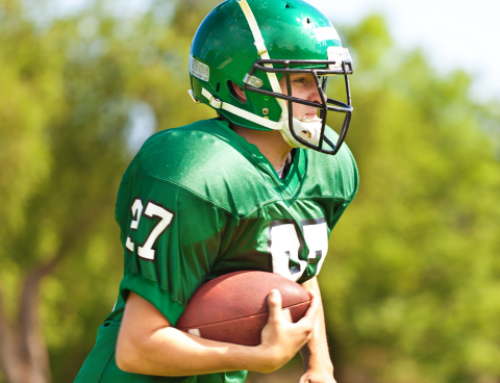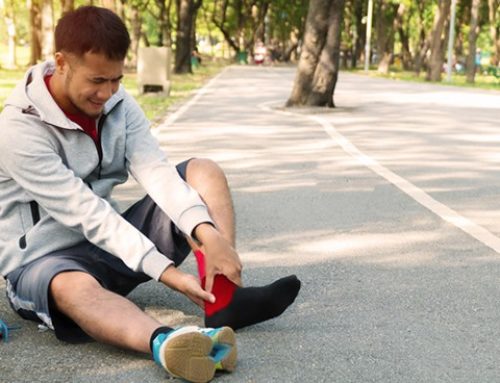Simple Ways to Treat or Prevent an Ankle Sprain
A sprained ankle is one of the most common joint injuries, prompting many athletes to consider it “just a sprain” and not treat it with the respect it deserves. The consequences of this neglect are persistent weakness, instability in the joint and the likelihood of repeated sprains. Ankle sprains are so often mistreated (or not treated at all), that experts say they have the highest recurrence rate of any joint injury, and they can result in chronic symptoms.
The National Athletic Trainers’ Association met with experts responsible for the ankle health of college athletes, reviewing the evidence for various methods assumed to help prevent recurrent ankle sprains. Their conclusion? Ankle sprains need more rehabilitation and take longer to heal than most athletes allow. Think now, how many athletes are playing with injured ankles?
Dr. Tricia Hubbard, of the University of North Carolina in Charlotte, expressed concern that 30 to 40 percent of athletes with simple ankle sprains develop chronic long-term injuries. Her research showed that with any ankle sprain, the ankle should be immediately immobilized to protect the joint and allow the reinjured ligaments to heal—and remain immobilized for at least week for a simple ankle sprain, 10 to 14 days for a moderate sprain, and four to six weeks for a severe sprain.
A sprain results when ligaments are stretched beyond their normal range. In a severe sprain, the elastic fibers tear partly or completely. In sports, common causes include coming down wrong after a jump shot or rebound; stepping on another player’s foot; and making quick directional changes, as in tennis, basketball, football, and soccer.
Classification of Ankle Sprains
Ankle sprains are categorized in three grades, depending on their severity.
- Grade I: Some stretching and possibly slight tearing. Little or no instability of the joint. Mild pain, swelling, and stiffness.
- Grade II: Some tearing of the ligaments and moderate instability of the joint. Moderate to severe pain, swelling and joint stiffness.
- Grade III: Total rupture of ligament(s) and severe instability of the joint. Severe pain and swelling, extreme joint stiffness.
Grade III sprains require immobilization for several weeks. Surgical repair or reconstruction may be necessary.
As with other such injuries, the recommended first aid for an ankle sprain, which should start as soon as possible after the injury, goes by the acronym RICE—Rest, Ice, Compression and Elevation.
An athletic trainer will prescribe RICE, a period of immobilization of the ankle and rehabilitation exercises. He or she will also decide whether the athlete should see a doctor or physical therapist.
Exercise Progression to Manage, Prevent and Treat Ankle Sprains
Athletes and their trainers must take the proper steps to manage, prevent and treat ankle injuries. Below are various prehab and/or rehab exercises for an ankle sprain, arranged in a progression. They can be done on your own before and after activity.
Seated Ankle Banded Stretches
[youtube video=”zwU8aAVT3do” /]Standard Toe and Heel Walks
On toes forward, pigeon toe, and toes pointed out; then heel walks in same patterns.
Alphabets – Upper Case and Lower Case
For serious ankle injuries, perform the ankle alphabet. It promotes range of motion and flexibility and builds strength before the athlete resumes activity.
Ankle Octagon Quick Foot Taps – Various Directions
[youtube video=”JZwwMti09iY” /]The following progressions are done after a session or game to ensure ankle mobility, keeping the ankle loose and functional until the athlete can get home and rest it.
Standing Ankle Banded Stretches
[youtube video=”aLYunOVotoA” /]Tim Grover’s Quick Seated Ankle-Banded Stretches
[youtube video=”lkCefAdmBsA” /]Learn more about treating and preventing ankle sprains:
RECOMMENDED FOR YOU
MOST POPULAR
Simple Ways to Treat or Prevent an Ankle Sprain
A sprained ankle is one of the most common joint injuries, prompting many athletes to consider it “just a sprain” and not treat it with the respect it deserves. The consequences of this neglect are persistent weakness, instability in the joint and the likelihood of repeated sprains. Ankle sprains are so often mistreated (or not treated at all), that experts say they have the highest recurrence rate of any joint injury, and they can result in chronic symptoms.
The National Athletic Trainers’ Association met with experts responsible for the ankle health of college athletes, reviewing the evidence for various methods assumed to help prevent recurrent ankle sprains. Their conclusion? Ankle sprains need more rehabilitation and take longer to heal than most athletes allow. Think now, how many athletes are playing with injured ankles?
Dr. Tricia Hubbard, of the University of North Carolina in Charlotte, expressed concern that 30 to 40 percent of athletes with simple ankle sprains develop chronic long-term injuries. Her research showed that with any ankle sprain, the ankle should be immediately immobilized to protect the joint and allow the reinjured ligaments to heal—and remain immobilized for at least week for a simple ankle sprain, 10 to 14 days for a moderate sprain, and four to six weeks for a severe sprain.
A sprain results when ligaments are stretched beyond their normal range. In a severe sprain, the elastic fibers tear partly or completely. In sports, common causes include coming down wrong after a jump shot or rebound; stepping on another player’s foot; and making quick directional changes, as in tennis, basketball, football, and soccer.
Classification of Ankle Sprains
Ankle sprains are categorized in three grades, depending on their severity.
- Grade I: Some stretching and possibly slight tearing. Little or no instability of the joint. Mild pain, swelling, and stiffness.
- Grade II: Some tearing of the ligaments and moderate instability of the joint. Moderate to severe pain, swelling and joint stiffness.
- Grade III: Total rupture of ligament(s) and severe instability of the joint. Severe pain and swelling, extreme joint stiffness.
Grade III sprains require immobilization for several weeks. Surgical repair or reconstruction may be necessary.
As with other such injuries, the recommended first aid for an ankle sprain, which should start as soon as possible after the injury, goes by the acronym RICE—Rest, Ice, Compression and Elevation.
An athletic trainer will prescribe RICE, a period of immobilization of the ankle and rehabilitation exercises. He or she will also decide whether the athlete should see a doctor or physical therapist.
Exercise Progression to Manage, Prevent and Treat Ankle Sprains
Athletes and their trainers must take the proper steps to manage, prevent and treat ankle injuries. Below are various prehab and/or rehab exercises for an ankle sprain, arranged in a progression. They can be done on your own before and after activity.
Seated Ankle Banded Stretches
[youtube video=”zwU8aAVT3do” /]Standard Toe and Heel Walks
On toes forward, pigeon toe, and toes pointed out; then heel walks in same patterns.
Alphabets – Upper Case and Lower Case
For serious ankle injuries, perform the ankle alphabet. It promotes range of motion and flexibility and builds strength before the athlete resumes activity.
Ankle Octagon Quick Foot Taps – Various Directions
[youtube video=”JZwwMti09iY” /]The following progressions are done after a session or game to ensure ankle mobility, keeping the ankle loose and functional until the athlete can get home and rest it.
Standing Ankle Banded Stretches
[youtube video=”aLYunOVotoA” /]Tim Grover’s Quick Seated Ankle-Banded Stretches
[youtube video=”lkCefAdmBsA” /]Learn more about treating and preventing ankle sprains:












